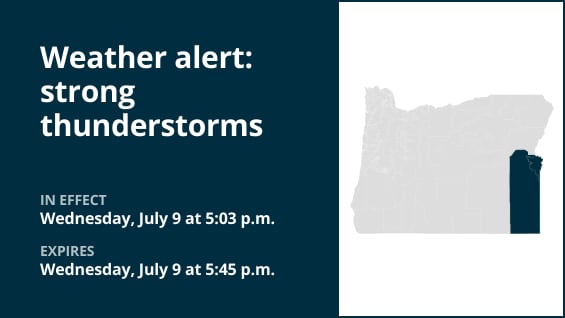On Wednesday at 5:03 p.m., the National Weather Service issued an updated forecast for the Oregon Lower Treasure Valley and Malheur County that called for heavy thunderstorms until 5:45 p.m.
Marble-sized hail (0.5 inches) and wind gusts of up to 50 mph are expected during the storms.
“At 5:02 p.m., Doppler radar tracked a cluster of strong thunderstorms near Double Mountain, or 18 miles west of Parma, moving northeast at 5 mph,” according to the weather service. Gusty winds have the potential to blow around unsecured objects and topple tree branches. Visibilities are decreased in areas when dust is blowing. It is possible for outdoor items to sustain minor harm.
The weather service remarks, “If you’re outside, think about taking cover inside a structure. Alongside this storm is torrential rain, which could cause localized flooding. Avoid operating a car on flooded roads.
Staying safe as lightning approaches: Expert advice
Approximately 25 million lightning strikes occur in the United States annually, with the majority of these electrical discharges taking place in the summer. Unfortunately, according to the weather service, lightning kills roughly 20 people every year. As thunderstorms approach, the likelihood of lightning-related incidents increases, peaking when the storm is directly overhead. But as the tempest sweeps away, it gradually fades away.
Remember the following advice to stay safe during a thunderstorm:
Plan for lightning safety:
-
When venturing outdoors, it’s crucial to have a lightning safety plan in place.
-
Stay vigilant by monitoring the sky for ominous signs and listening for the telltale sound of thunder. If thunder is audible, it’s a clear indication of nearby lightning.
-
Seek shelter promptly in a safe location, preferably indoors.
Indoor safety precautions:
-
Once you’ve found shelter indoors, abstain from using corded phones, electrical appliances, or plumbing fixtures, and refrain from approaching windows and doors.
-
These precautions help reduce the risk of electrical surges, as lightning can follow conductive pathways.
Hold off till the all-clear:
-
After the last lightning strike or thunderclap, wait at least 30 minutes before resuming outdoor activities.
-
Lightning can strike even when a storm has seemingly passed, so exercise caution.
When there is no indoor shelter:
Take these precautions to increase your safety if you are outside during a thunderstorm without access to inside shelter:
-
Avoid open fields, hilltops, or ridge crests, as they expose you to greater lightning risk.
-
Steer clear of tall, isolated trees and other prominent objects. In wooded areas, stay close to lower stands of trees.
-
If you’re in a group, ensure that individuals are spaced out to prevent lightning current from transferring between people.
-
Camping in an open setting during a thunderstorm is strongly discouraged. If no alternative exists, set up camp in a valley, ravine, or other low-lying areas. Remember that a tent offers no protection against lightning.
-
Do not approach water bodies, wet objects, or metal items. Although water and metal do not attract lightning, they conduct electricity effectively and can pose significant risks.
In conclusion, being alert and ready are your best defenses against lightning threats. You may put your safety first and drastically lower the likelihood of lightning-related mishaps by adhering to these rules.
Mastering wet roads: Safety tips for heavy rainfall
Roads can become dangerous when it rains. Keep yourself updated and heed these weather service recommendations to stay safe during periods of intense precipitation:
Watch out for flooding rivers:
Avoid parking or strolling close to culverts or drainage ditches during periods of intense precipitation, as the swift-moving water can be quite dangerous.
Keep your distances from other vehicles safe:
In heavy rain, the two-second rule of following distance is your friend. To guarantee safe spacing under unfavorable circumstances, increase it to four seconds.
Slow down and drive carefully:
Lowering your speed is essential on wet roads. To prevent skidding, gently release the gas pedal and refrain from applying sudden braking.
Pick your lane carefully:
To reduce the chance of hydroplaning, stay in the middle lanes. Water is more likely to accumulate in outside lanes.
Visibility is important.
Turn on your headlights to improve visibility in severe rain. Rain-stained windows can make it difficult to see cars in blind zones, so be especially alert for them.
Be cautious on slick roads:
During the first half hour after the rain starts, exercise additional caution. The road becomes slick when water combines with dirt and oil on the surface.
Stay a safe distance away from big cars:
Tire spray from big vehicles and buses can make it harder to see. Pass them quickly and safely, and refrain from tailgating.
Be mindful of your wipers:
Visibility may be hampered by overloaded wiper blades. If the rain makes it very difficult to see, stop and wait for the weather to clear up. Look for cover in covered areas or rest areas.
If you can’t avoid the roadside, pull off as far as you can, ideally past the end of a guard rail, and wait for the storm to pass. To let other cars know where you are, turn on your emergency flashers and keep your headlights on.
You may greatly lower dangers and protect your health when it rains a lot by adhering to these safety precautions. To ensure a safe and sound voyage, keep yourself updated on weather conditions and follow local authorities’ instructions.
United Robots offers a service called Advance Local Weather Alerts that gathers the most recent information from the National Weather Service using machine learning.





More Stories
Update: Marble-sized hail expected with thunderstorms to hit Oregon Lower Treasure Valley and Malheur County Wednesday
Update: Marble-sized hail expected with thunderstorms to hit Oregon Lower Treasure Valley and Malheur County Wednesday
Update: Marble-sized hail expected with thunderstorms to hit Oregon Lower Treasure Valley and Malheur County Wednesday